|
News Archive |

|
Comet Tempel 1 has another 'sneeze' outburst
NASA's Deep Impact spacecraft have observed a massive, short-lived outburst of ice or other particles from comet Tempel 1 that temporarily expanded the size and reflectivity of the cloud of dust and gas (coma) that surrounds the comet nucleus.
 FULL STORY FULL STORY
 DEEP IMPACT PREVIEW DEEP IMPACT PREVIEW
 |  |

|
 |
Hibernating spacecraft awakens for comet impact
The Submillimeter Wave Astronomy Satellite has been asleep on orbit for the past 11 months. SWAS operators placed it into hibernation after a highly successful 5.5-year mission highlighted by the discovery of a swarm of comets evaporating around an aging red giant star. Now, they have awakened SWAS again for the first-ever opportunity to study a comet on a collision course with a U.S. space probe.
 FULL STORY FULL STORY
 |  |

|
 |
Board: Shuttle safe despite missing 3 recommendations
An independent panel charged with assessing NASA's implementation of post-Columbia safety upgrades said in its final hearing Monday that the agency has failed to fully implement three of the most critical safety upgrades recommended by the Columbia Accident Investigation Board.
 FULL STORY FULL STORY
 |  |

|
 |

Additional coverage for subscribers:
 VIDEO:
MONDAY'S TASK GROUP NEWS BRIEFING DIAL-UP | BROADBAND VIDEO:
MONDAY'S TASK GROUP NEWS BRIEFING DIAL-UP | BROADBAND
 AUDIO:
LISTEN TO THE BRIEFING FOR IPOD AUDIO:
LISTEN TO THE BRIEFING FOR IPOD
 MORE: SHUTTLE RETURN TO FLIGHT VIDEO LISTING MORE: SHUTTLE RETURN TO FLIGHT VIDEO LISTING
 SUBSCRIBE NOW SUBSCRIBE NOW

|
Comet targeted by Deep Impact has an outburst
In a dress rehearsal for the rendezvous between NASA's Deep Impact spacecraft and comet 9P/Tempel 1, the Hubble Space Telescope captured dramatic images of a new jet of dust streaming from the icy comet.
 FULL STORY FULL STORY
 |  |

|
 |
Spots on Janus
This close-up look at Saturn's moon Janus reveals spots on the moon's surface which may be dark material exposed by impacts. Janus may be a porous body, composed mostly of water ice.
 FULL STORY FULL STORY
 |  |

|
 |
Protoplanetary systems found common in the galaxy
Astronomers using the Submillimeter Array on Mauna Kea, Hawaii, have confirmed, for the
first time, that many of the objects termed "proplyds" found in the Orion Nebula do have sufficient material to form new planetary systems like our own.
 FULL STORY FULL STORY
 |  |

|
 |
OTHER HEADLINES Additional stories today
|
 |
Veteran astronaut Dan Bursch leaves NASA -- Astronaut Daniel W. Bursch, who shares a U.S. space endurance record with astronaut Carl Walz, has retired from NASA to join The Aerospace Corporation as the National Reconnaissance Office Chair at the Naval Postgraduate School.

Child of Apollo era becomes chief of NASA flight directors -- Growing up in the Midwest's Quad Cities area during the Apollo era, Jeff Hanley was captivated by the media coverage of every mission. Hanley spent hours pasting together scrapbooks and recreating the moonwalks on each flight in his backyard. With each mission, his passion for human spaceflight grew, eventually becoming his professional life's ambition.
|
 |
Detour: Planetary construction zone ahead
Interstellar travelers might want to detour around the star system TW Hydrae to avoid a messy planetary construction site. Astronomers have discovered that the gaseous protoplanetary disk surrounding TW Hydrae holds vast swaths of pebbles extending outward for at least 1 billion miles. These rocky chunks should continue to grow in size as they collide and stick together until they eventually form planets.
 FULL STORY FULL STORY
 |  |

|
 |
'Virtual crew assistant' to be demonstrated
Intelligent conversation with robots - long the bread and butter of science fiction authors - soon may take another step closer to reality for astronauts on the International Space Station.
 FULL STORY FULL STORY
 |  |

|
 |
Shuttle launch debris risk uncertain but 'acceptable'
NASA managers met Friday and decided to press ahead with plans to launch the shuttle Discovery next month even though engineers have been unable to precisely define the threat posed by ice shaking off the ship's external tank during launch.
 FULL STORY FULL STORY
 |  |

|
 |

Additional coverage for subscribers:
 VIDEO:
"DEBRIS 101" EXPLAINS WHAT THREATENS THE SHUTTLE QT VIDEO:
"DEBRIS 101" EXPLAINS WHAT THREATENS THE SHUTTLE QT
 VIDEO:
REVIEW OF NASA'S EXTENSIVE IMPACT TESTING PERFORMED QT VIDEO:
REVIEW OF NASA'S EXTENSIVE IMPACT TESTING PERFORMED QT
 VIDEO:
PRESENTATION ON THE CHANGES MADE TO THE TANK QT VIDEO:
PRESENTATION ON THE CHANGES MADE TO THE TANK QT
 VIDEO:
DAY-BY-DAY PREVIEW OF DISCOVERY'S MISSION QT VIDEO:
DAY-BY-DAY PREVIEW OF DISCOVERY'S MISSION QT
 VIDEO:
DETAILED SUMMARY OF MISSION'S THREE SPACEWALKS QT VIDEO:
DETAILED SUMMARY OF MISSION'S THREE SPACEWALKS QT
 VIDEO:
STS-114 ACTIVITIES PLANNED ABOARD AND OUTSIDE ISS QT VIDEO:
STS-114 ACTIVITIES PLANNED ABOARD AND OUTSIDE ISS QT
 VIDEO:
CHANGES TO LAUNCH AND LANDING OPERATIONS QT VIDEO:
CHANGES TO LAUNCH AND LANDING OPERATIONS QT
 MORE: SHUTTLE RETURN TO FLIGHT VIDEO LISTING MORE: SHUTTLE RETURN TO FLIGHT VIDEO LISTING
 SUBSCRIBE NOW SUBSCRIBE NOW

|
Russians loft modernized communications satellite
��A Proton booster successfully rocketed into space late Friday to loft a Russian civil communications bird that will be pressed into service to serve users across eastern Russia.
 FULL STORY FULL STORY
 |  |

|
 |
Whirling atoms dance into physics textbooks
NASA-funded researchers at the Massachusetts Institute of Technology, Cambridge, Mass., have created a new form of superfluid matter. This research may lead to improved superconducting materials, useful for energy-efficient electricity transport and better medical diagnostic tools.
 FULL STORY FULL STORY
 |  |

|
 |
'Bumpy space dust' explains common molecule
Science fiction writer Harlan Ellison once said that the most common elements in the universe are hydrogen and stupidity.
 FULL STORY FULL STORY
 |  |
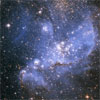
|
 |
NASA researchers studying tropical cyclones
NASA hurricane researchers are deploying to Costa Rica next month to investigate the birthplace of eastern Pacific tropical cyclones. They will be searching for clues that could lead to a greater understanding and better predictability of one of the world's most significant weather events - the hurricane.
 FULL STORY FULL STORY
 |  |

|
 |
Sea Launch rocket lofts satellite for the Americas
Floating on a launch platform in the equatorial Pacific Ocean far from anywhere, a 20-story rocket roared to life in the peaceful predawn darkness Thursday morning to haul a telecommunications satellite into space to serve the Americas.
 FULL STORY FULL STORY
 MISSION STATUS CENTER MISSION STATUS CENTER
 |  |

|
 |
Hubble images of dust belt point to planet's presence
Astronomers zooming in on a nearby star with NASA's Hubble Space Telescope have discovered unmistakable evidence of a planetary system: a perturbed dusty belt around the star that's analogous to the vast Kuiper Belt of icy rocks encircling the sun.
 FULL STORY FULL STORY
 |  |

|
 |
Mars Express radar ready to begins its probing work
MARSIS, the advanced radar onboard ESA's Mars Express orbiter, is now fully deployed, has undergone its first checkout and is ready to start operations around the Red Planet. With this radar, the Mars Express orbiter at last has its full complement of instruments available to probe the planet's atmosphere, surface and subsurface structure.
 FULL STORY FULL STORY
 |  |
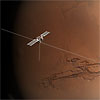
|
 |
Confusion over solar sail's fate continues
While solar sail project leaders cling to diminishing hope that their tiny spacecraft achieved orbit Tuesday, Russian launch officials say the modified booster rocket malfunctioned and crashed.
 LATEST UPDATE LATEST UPDATE
 TUESDAY EVENING STORY TUESDAY EVENING STORY
 LAUNCH PREVIEW STORY LAUNCH PREVIEW STORY
 |  |

|
 |
Weekend Delta 4 launch delayed to next month
Concerns over the onboard batteries that power the Boeing Delta 4 rocket's safety destruct system has forced another delay in launching the GOES-N civilian weather satellite. Sunday evening's planned liftoff from Cape Canaveral will be postponed until sometime in July as a result.
 FULL STORY FULL STORY
 |  |

|
 |
Architect of Air Force space and missile programs dies
Retired Gen. Bernard Adolph Schriever, widely regarded as the father and architect of the Air Force space and ballistic missile programs, died of natural causes at home in Washington on Monday. He was 94.
 FULL STORY FULL STORY
 |  |

|
 |
Russian military rocket launch fails to reach orbit
A Russian military communications satellite was destroyed during launch Tuesday when the Molniya M rocket booster experienced a third stage malfunction about six minutes after the 0049 GMT liftoff from Plesetsk Cosmodrome. The vehicle failed to reach orbit, crashing back to Earth. Russian media reports indicated the impact site was in Siberia. The Molniya M is a four-stage rocket derived from the venerable Soyuz family.
 FULL STORY FULL STORY
 |  |
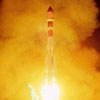
|
 |
Guinness recognizes X-43A scramjet speed record
It's official. The new world speed record for a jet-powered aircraft, set by NASA in November, has been officially recognized by Guinness World Records.
 FULL STORY FULL STORY
 |  |
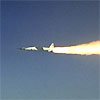
|
 |
Program analysis office formed by NASA chief
NASA Administrator Michael Griffin announced Monday the establishment of the Office of Program Analysis and Evaluation, headed by Dr. Scott Pace. "This office will provide independent analysis to me on all aspects of NASA programs that is objective, multidisciplinary and as transparent as possible," Griffin said.
 FULL STORY FULL STORY
 |  |

|
 |
Pandora's flocks observed by NASA's Cassini orbiter
The shepherd moon, Pandora, is seen here alongside the narrow F ring that it helps maintain. Pandora is 52 miles across. The appearance of Pandora here is exciting, as the moon's complete shape can be seen, thanks to reflected light from Saturn, which illuminates Pandora's dark side. The hint of a crater is visible on the dark side of the moon.
 FULL STORY FULL STORY
 |  |

|
 |
Cassini gives four views of Saturn's strange F ring
This montage of four images of Saturn's knotted F ring shows different locations around the ring, even though all taken within a few hours of each other. There is considerable variation in the structure of the ring at these four locations.
 FULL STORY FULL STORY
 |  |

|
 |
Weather satellite launch delayed by lightning
Lightning strikes uncomfortably close to Boeing's Delta 4 rocket pad at Cape Canaveral is prompting technicians to re-verify electronics and circuitry before a U.S. weather observatory can be launched into space this month.
 FULL STORY FULL STORY
 |  |
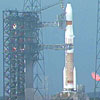
|
 |
Problem forces manual docking of ISS cargo ship
Space station commander Sergei Krikalev grabbed manual control of an approaching resupply ship Saturday, guiding the Progress ship to docking with the outpost at 8:42 p.m. EDT. A ground problem prevented controllers from uplinking a command to Progress that would have initiated the planned automated docking. From inside the station's living quarters, Krikalev used joysticks and camera views to bring the freighter to the safe docking.
 FULL STORY FULL STORY
 EARLIER STORY EARLIER STORY
 |  |
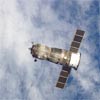
|
 |

Additional coverage for subscribers:
 VIDEO:
PROGRESS DOCKS TO STATION SHORT | EXTENDED VERSION VIDEO:
PROGRESS DOCKS TO STATION SHORT | EXTENDED VERSION
 SUBSCRIBE NOW SUBSCRIBE NOW

|
Fingerprinting a comet
The Submillimeter Array will be ready and watching when NASA's Deep Impact probe strikes the nucleus of Comet Tempel 1 on July 4th. The impact is expected to excavate material from the comet's interior-material left over from the earliest days of our solar system.
 FULL STORY FULL STORY
 |  |
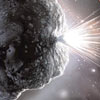
|
 |
Future astrobiology center is approved at Arizona
The Arizona Board of Regents has approved the creation of a center for the study of astrobiology at The University of Arizona. The center, called the Life and Planets Astrobiology Center, will bring more UA researchers from various fields together to study the existence of life elsewhere in the universe.
 FULL STORY FULL STORY
 |  |
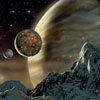
|
 |
Array stares into the throat of protostar jet
Astronomers find jets everywhere when they look into space. Small jets spout from newborn stars, while huge jets blast out of the centers of galaxies. Yet despite their commonness, the processes that drive them remain shrouded in mystery. Even relatively nearby stellar jets hide their origins behind almost impenetrable clouds of dust.
 FULL STORY FULL STORY
 |  |

|
 |
Russian space lab ferries experiments back to Earth
An international collection of experiments safely returned to Earth on Thursday with a fiery sunrise re-entry aboard the recoverable Foton space capsule after spending over two weeks conducting operations and studies in orbit.
 FULL STORY FULL STORY
 |  |

|
 |
Mars rovers continue their odyssey beyond 1,000 days
Luck, it has been said, favors the well prepared. That explains, perhaps, the fortune of the plucky Mars rovers Spirit and Opportunity -- and their creators, including Cornell Professor Steve Squyres, scientific leader of the NASA mission, back on Earth.
 FULL STORY FULL STORY
 |  |
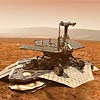
|
 |
Are meteor showers misunderstood?
NASA's Deep Impact mission is about to smash into comet 9P/Tempel 1 to excavate a crater and probe the comet's internal structure. It's possible, however, that the comet will break into fragments, creating a cloud of meteoroids. That, say astronomers, may not be unnatural.
 FULL STORY FULL STORY
 |  |

|
 |
Space shuttle Discovery moves back to launch pad
The space shuttle Discovery, bolted to an upgraded external tank and a fresh set of boosters, was hauled back out to pad 39B Wednesday for work to ready the ship for blastoff July 13.
 FULL STORY FULL STORY
 MISSION STATUS CENTER - live updates! MISSION STATUS CENTER - live updates!
 |  |

|
 |

Additional coverage for subscribers:
 VIDEO:
FINAL PREPS ARE MADE FOR ROLLOUT QT VIDEO:
FINAL PREPS ARE MADE FOR ROLLOUT QT
 VIDEO:
DISCOVERY BEGINS ITS JOURNEY TO THE PAD QT VIDEO:
DISCOVERY BEGINS ITS JOURNEY TO THE PAD QT
 VIDEO:
THE SHUTTLE EMERGES FROM THE ASSEMBLY BUILDING QT VIDEO:
THE SHUTTLE EMERGES FROM THE ASSEMBLY BUILDING QT
 VIDEO:
DAY BREAKS OVER KENNEDY SPACE CENTER QT VIDEO:
DAY BREAKS OVER KENNEDY SPACE CENTER QT
 VIDEO:
HOT TRANSPORTER BEARING CAUSES PROBLEMS QT VIDEO:
HOT TRANSPORTER BEARING CAUSES PROBLEMS QT
 VIDEO:
DISCOVERY NEARS PAD 39B AFTER THE LONG JOURNEY QT VIDEO:
DISCOVERY NEARS PAD 39B AFTER THE LONG JOURNEY QT
 VIDEO:
TRANSPORTER CLIMBS UP THE LAUNCH PAD RAMP QT VIDEO:
TRANSPORTER CLIMBS UP THE LAUNCH PAD RAMP QT
 VIDEO:
DISCOVERY ARRIVES AT ITS LAUNCH COMPLEX QT VIDEO:
DISCOVERY ARRIVES AT ITS LAUNCH COMPLEX QT
 MORE: SHUTTLE RETURN TO FLIGHT VIDEO LISTING MORE: SHUTTLE RETURN TO FLIGHT VIDEO LISTING
 SUBSCRIBE NOW SUBSCRIBE NOW

|
Space-to-Congress linkup allows astronaut to testify
NASA's astronaut aboard the International Space Station made history Tuesday becoming the first to testify before Congress while in orbit. Expedition 11 crew member John Phillips appeared via satellite before the House Science Committee, Subcommittee on Space and Aeronautics, chaired by Rep. Ken Calvert, R-Calif.
 FULL STORY FULL STORY
 |  |

|
 |

Additional coverage for subscribers:
 VIDEO:
THE HISTORIC CONGRESSIONAL HEARING BEGINS QT VIDEO:
THE HISTORIC CONGRESSIONAL HEARING BEGINS QT
 VIDEO:
ASTRONAUT PHILLIPS TESTIFIES FROM ISS QT VIDEO:
ASTRONAUT PHILLIPS TESTIFIES FROM ISS QT
 VIDEO:
FORMER ISS RESIDENTS APPEAR AT HEARING QT VIDEO:
FORMER ISS RESIDENTS APPEAR AT HEARING QT
 SUBSCRIBE NOW SUBSCRIBE NOW

|
OTHER HEADLINES Additional stories today
|
 |
Hybrid rocket test at Edwards AFB is successful -- A hybrid rocket motor intended to provide a low-cost responsive small launch vehicle (SLV) was recently tested for the second time here at Edwards Air Force Base, California.

Arianespace will launch BSAT-3a for Japan -- Arianespace CEO Jean-Yves Le Gall announced Tuesday at the Paris Air Show that Lockheed Martin Commercial Space Systems has contracted with Arianespace to launch the BSAT-3a spacecraft for the Broadcasting Satellite System Corporation (B-SAT) of Japan.
|
 |
Shuttle Discovery flight preps chronicled in video
As excitement builds for the first space shuttle launch in over two years, this comprehensive video selection features the major pre-flight events for Discovery and her seven astronauts.
 SEE VIDEO COLLECTION SEE VIDEO COLLECTION
 |  |

|
 |
Astronomers discover active Earth-like planet
Taking a major step forward in the search for Earth-like planets beyond our own solar system, a team of astronomers has announced the discovery of the smallest extrasolar planet yet detected. About seven-and-a-half times as massive as Earth, with about twice the radius, it may be the first rocky planet ever found orbiting a normal star not much different from our Sun.
 FULL STORY FULL STORY
 |  |

|
 |
Balloon-borne telescope looks to distant galaxies
Astronomers have launched the most highly sensitive telescope of its kind to be carried by balloon. The Balloon-borne Large Aperture Sub-millimeter Telescope - or BLAST - will take a five to nine-day journey along the upper reaches of Earth's atmosphere. BLAST will collect images of objects in our solar system as well as the distant light that details the formation of stars and the evolution of whole galaxies.
 FULL STORY FULL STORY
 |  |

|
 |
OTHER HEADLINES Additional stories today
|
 |
Atlas 5 picked by Inmarsat for launch agreement -- Less than three months after the successful launch of the first of its next-generation satellites, Inmarsat has returned to International Launch Services to add the Atlas V vehicle as an option for future I-4 launches.

Air Force weather satellite delivered to launch site -- The Defense Meteorological Satellite Program (DMSP) F-17 Block 5D-3 spacecraft, built under contract for the U.S. Air Force by Lockheed Martin Space Systems Company, Sunnyvale, Calif., has been delivered to Vandenberg Air Force Base, Calif., in preparation for a December launch.
|
 |
Mars rover Spirit freezes a beautiful moment in time
NASA's Mars Exploration Rover Spirit took this stunning view as the Sun sank below the rim of Gusev crater. The mosaic is yet another example of a beautiful, sublime martian scene that also captures some important scientific information.
 FULL STORY FULL STORY
 |  |

|
 |
Hot on the trail of nature's exotic flashers
Astronomers have uncovered tantalizing insights into the origin of short gamma-ray bursts - mysterious, split-second high-energy flashes that have eluded detailed study until now. Unlike their long-duration cousins, which are known to arise when massive young stars die, short bursts are thought to occur when old, dense neutron stars collide.
 FULL STORY FULL STORY
 |  |

|
 |
OTHER HEADLINES Additional stories today
|
 |
New sensor will measure Earth's energy loss -- NASA successfully tested a new instrument that will provide scientists with unprecedented measurements to further the agency's understanding of climate change.

NASA and Russians team up for gravity studies -- NASA scientists are collaborating with Russian colleagues in an effort to learn more about cell growth in space. The experiments were launched May 31 aboard the Russian Foton-M2 mission from the Baikonur Cosmodrome in Kazakhstan, and will be recovered 16 days later when the capsule returns to Earth near the border between Russia and Kazakhstan.
|
 |
Spitzer observes echo of neutron star outburst
Astronomers observing with NASA's Spitzer Space Telescope say they may have seen the infrared "echo" of a neutron star that sent a blast wave from inside supernova remnant Cassiopeia A about 50 years ago.
 FULL STORY FULL STORY
 |  |

|
 |
Saturn's embedded Atlas
From a viewing angle slightly above the ringplane Cassini spied Saturn's moon Atlas, which orbits Saturn between the broad A ring and the thin F ring. The background of Saturn's atmosphere (a uniform grey in this image) lies 47,000 miles beyond the little moon, which is just 20 miles across.
 FULL STORY FULL STORY
 |  |

|
 |
One view, multiple worlds
Three very different worlds crowd the frame in this unique view from the Cassini spacecraft, which although partly overexposed, provides a splendid look at several major targets of interest for the mission.
 FULL STORY FULL STORY
 |  |

|
 |
World's largest satellite delivered to launch base
The iPSTAR-1 satellite has arrived at the Arianespace spaceport in Kourou, French Guiana, and is undergoing preparations for launch aboard an Ariane 5 rocket on July 7. With a launch weight of 14,341 pounds, the Space Systems/Loral-built iPSTAR-1 will be the heaviest commercial satellite ever delivered to geosynchronous orbit.
 FULL STORY FULL STORY
 |  |

|
 |
OTHER HEADLINES Additional stories today
|
 |
New space shuttle landing site established -- The governments of the United States of America and the French Republic have agreed to establish a Transoceanic Abort Landing (TAL) site for NASA's Space Shuttle at Istres Air Base 125, in the South of France.

Loral to build next XM Satellite Radio craft -- Space Systems/Loral (SS/L) announced that it has been awarded a contract by XM Satellite Radio, Washington DC, to build XM-5, a high-power, digital audio radio service (DARS) satellite that will serve as a ground spare in the XM Satellite Radio fleet, ensuring XM subscribers across North America with continued high-quality, digital- music, entertainment and data services.
|
 |
Possible volcano discovered on Saturn's moon Titan
A recent flyby of Saturn's hazy moon Titan by the Cassini spacecraft has revealed evidence of a possible volcano, which could be a source of methane in Titan's atmosphere.
 FULL STORY FULL STORY
 |  |

|
 |
Aurora found on Mars
Mars has an aurora, and it's like none other in the solar system. The European Space Agency's Mars Express orbiter detected the unique phenomenon with its ultraviolet instrument. French, U.S. and Russian scientists were reporting the discovery Wednesday.
 FULL STORY FULL STORY
 |  |
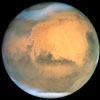
|
 |
Hubble reveals 'supernova remnant menagerie'
A violent and chaotic-looking mass of gas and dust is seen in this Hubble Space Telescope image of a nearby supernova remnant. Denoted N 63A, the object is the remains of a massive star that exploded, spewing its gaseous layers out into an already turbulent region.
 FULL STORY FULL STORY
 |  |

|
 |
European Space Agency approves Mars boom deploy
Following in-depth analyses performed after problems encountered during the deployment of the first MARSIS antenna boom on board Mars Express, the European Space Agency has decided to proceed with extending the second boom.
 FULL STORY FULL STORY
 |  |

|
 |
NASA nixes third tanking test for shuttle Discovery
NASA managers Monday ruled out a third tanking test for the shuttle Discovery, keeping launch of the first post-Columbia mission on target for July 13. The launch window extends to July 31 and as of this writing, engineers have five days of contingency time in the launch processing schedule to handle unexpected problems between now and the opening of the window.
 FULL STORY FULL STORY
 |  |

|
 |
Cosmic mystery: Where is that missing neutron star?
In 1987, earthbound observers saw a star explode in the nearby galaxy. Astronomers eagerly studied this supernova -- the closest seen in the past 300 years -- and have continued to examine its remains. Although its blast wave lit up surrounding clouds of gas and dust, the supernova appears to have left no core behind. Astronomers now report that even Hubble's sharp eyes failed to locate the black hole or ultracompact neutron star they believe was created by the star's death.
 FULL STORY FULL STORY
 |  |

|
 |
Key evidence supporting theory of quasars found
The office that astronomer Lei Hao shares with her fellow research associates on the first floor of the Space Sciences Building at Cornell University is tidy and organized. But Hao has been thinking a lot lately about dust. Actually, she's recently found a great deal of it. And she's thrilled.
 FULL STORY FULL STORY
 |  |

|
 |
NASA's newest mission: Orbiting the king of planets
For the next bold step to robotically explore the solar system, NASA has chosen a heavily instrumented probe to orbit Jupiter's poles over an ambitious mission to return samples from the Moon's mysterious south pole.
 FULL STORY FULL STORY
 |  |

|
 |
Mars rover Opportunity finally escapes sandy trap
A thick extraterrestrial sand dune was no match for an army of engineers and scientists who worked for over a month to free NASA's Opportunity rover from its clenching grasp on the surface of Mars. The mission's chief scientist says additional safeguards will be put in place to avoid such a problem during future drives.
 FULL STORY FULL STORY
 |  |

|
 |
Photo gallery: Demating space shuttle Discovery
After rolling back to the Vehicle Assembly Building from launch pad 39B, technicians demated space shuttle Discovery and its original external fuel tank. Discovery will be attached with another tank and set of solid rocket boosters for the return-to-flight mission. The new tank has additional ice-fighting heaters and instrumentation.
 ENTER PHOTO GALLERY ENTER PHOTO GALLERY
 |  |

|
 |

Additional coverage for subscribers:
 VIDEO:
TECHNICIANS PREPARE DISCOVERY FOR DEMATING QT VIDEO:
TECHNICIANS PREPARE DISCOVERY FOR DEMATING QT
 VIDEO:
SHUTTLE DISCOVERY IS REMOVED FROM TANK QT VIDEO:
SHUTTLE DISCOVERY IS REMOVED FROM TANK QT
 SUBSCRIBE NOW SUBSCRIBE NOW

|
Deep roots of solar wind help predict space weather
A layer deep in the solar atmosphere can be used to estimate the speed of the solar wind, a stream of electrified gas that constantly blows from the Sun. Estimating the speed of the solar wind will improve space weather forecasts, enhancing our ability to protect communications, navigation, and other satellites from the effects of solar storms.
 FULL STORY FULL STORY
 |  |

|
 |
Scientists confirm liquid water on early Earth
Research funded partly by NASA has confirmed the existence of liquid water on the Earth's surface more than 4 billion years ago.
 FULL STORY FULL STORY
 |  |

|
 |
Phoenix Mars mission begins launch preparations
NASA has given the green light to a project to put a long-armed lander on to the icy ground of the far-northern Martian plains. NASA's Phoenix lander is designed to examine the site for potential habitats for water ice, and to look for possible indicators of life, past or present.
 FULL STORY FULL STORY
 |  |
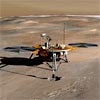
|
 |
NASA's space eyes focus on Deep Impact comet target
On July 4, NASA's Deep Impact spacecraft will attempt an extraordinarily daring encounter with the far-flung comet Tempel 1 hurtling through space at tens of thousands of miles per hour. As if that is not challenging enough, the comet's size, shape and other characteristics are not entirely known.
 FULL STORY FULL STORY
 |  |

|
 |
Stars flooding space with gravitational waves
A scientist using NASA's Chandra X-ray Observatory has found evidence that two white dwarf stars are orbiting each other in a death grip, destined to merge.
 FULL STORY FULL STORY
 |  |

|
 |
Evidence for extensive, olivine-rich bedrock on Mars
By using new, high spatial resolution infrared data from NASA's Mars Odyssey spacecraft, scientists have concluded that a region on the surface of Mars known to contain olivine-rich rocks is actually four times larger than previously estimated.
 FULL STORY FULL STORY
 |  |

|
 |
Jupiter moon throws curve ball at formation theories
Scientists studying data from NASA's Galileo spacecraft have found that Jupiter's moon Amalthea is a pile of icy rubble less dense than water. Scientists expected moons closer to the planet to be rocky and not icy. The finding shakes up long-held theories of how moons form around giant planets.
 FULL STORY FULL STORY
 |  |

|
 |
Satellite shutdown threatens science study
Observations of a cosmic explosion detected by two NASA satellites have thrown into doubt one popular explanation for such explosions and have also seriously weakened the argument for yet another, according to a University of Chicago astrophysicist. But solving the mystery any time soon may be forestalled by plans to shut down one of the satellites in September.
 FULL STORY FULL STORY
 |  |

|
 |
Telescope catches surprise ultraviolet light show
It was a day like any other for a nearby star named GJ 3685A - until it suddenly exploded with light. At 2 p.m., the detectors on NASA's Galaxy Evolution Explorer ultraviolet space telescope nearly overloaded when the star abruptly brightened by a factor of at least 10,000. After the excitement was over, astronomers realized that they had just recorded a giant star eruption, or flare, about one million times more energetic than those from our Sun.
 FULL STORY FULL STORY
 |  |

|
 |
Mercury-bound probe snaps shots of Earth
NASA's Mercury-bound MESSENGER spacecraft - less than three months from an Earth flyby that will slingshot it toward the inner solar system - successfully tested its main camera by snapping distant approach shots of Earth and the Moon.
 FULL STORY FULL STORY
 |  |

|
 |
Shuttle Discovery's crew
Five men and two woman will launch aboard space shuttle Discovery for the first post-Columbia mission this summer, putting their lives on the line. The crew includes the first woman to command a shuttle mission, an Australian-born astronaut who lived on Mir and a Japanese space rookie. Get to know these astronauts through a series of one-on-one interviews.
 FULL COVERAGE FULL COVERAGE
 |  |

|
 |
Columbia and lost Foton experiments re-launched
A diverse suite of science experiments from around the world is now in space after a flawless launch aboard a Russian Soyuz rocket Tuesday. The Foton microgravity research capsule is packed with experiments being reflown after losses in two space disasters -- shuttle Columbia and the failed Foton-M1 -- for a 16-day orbital mission before returning to Earth in mid-June.
 FULL STORY FULL STORY
 |  |

|
 |
Spitzer captures fruits of massive stars' labors
The saga of how a few monstrous stars spawned a diverse community of additional stars is told in a new image from NASA's Spitzer Space Telescope.
 FULL STORY FULL STORY
 |  |

|
 |
New evidence for violent demise of sun-like stars
Two astronomers have used NASA's Chandra X-ray Observatory to discover a shell of superheated gas around a dying star in the Milky Way galaxy. The discovery shows how material ejected at two million miles per hour during the final, dying stages of sun-like stars can heat previously ejected gas to the point where it will emit X-rays.
 FULL STORY FULL STORY
 |  |

|
 |
Memorial Day message from space station
The International Space Station's Expedition 11 crew pays tribute to our fallen heroes for Memorial Day in this video downlinked from the orbiting outpost. The movie can be downloaded by Spaceflight Now Plus users.
 |  |

|
 |

Additional coverage for subscribers:
 VIDEO:
WATCH THE MEMORIAL DAY MESSAGE QT VIDEO:
WATCH THE MEMORIAL DAY MESSAGE QT
 SUBSCRIBE NOW SUBSCRIBE NOW

|
Researcher sheds new light on solar storms
New research links a particular magnetic structure on the Sun with the genesis of powerful solar storms that can buffet Earth's atmosphere. The research may enable scientists to create more accurate computer models of the solar storms, and could eventually point the way to forecasting the storms days before they occur.
 FULL STORY FULL STORY
 |  |

|
 |
Clues to planet formation
The most detailed measurements to date of the dusty disks around young stars confirm a new theory that the region where rocky planets such as Earth form is much farther away from the star than originally thought.
 FULL STORY FULL STORY
 |  |

|
 |
Privately-made Falcon 1 rocket roars on the pad
Rocket-launch newcomer Space Exploration Technologies Corp. on Friday accomplished a critical engine firing at California's Vandenberg Air Force Base, a long-awaited event that puts the company much closer to its inaugural blastoff later this summer.
 FULL STORY FULL STORY
 EARLIER PROFILE OF SPACEX EARLIER PROFILE OF SPACEX
 SPACEX PLANS CAPE LAUNCH PAD SPACEX PLANS CAPE LAUNCH PAD
 |  |
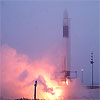
|
 |
Solar fireworks signal new space weather mystery
The most intense burst of solar radiation in five decades accompanied a large solar flare on January 20. It shook space weather theory and highlighted the need for new forecasting techniques, according to several presentations made at the American Geophysical Union meeting this week in New Orleans.
 FULL STORY FULL STORY
 |  |

|
 |
What triggers universe's most powerful explosions?
Observations by two of the world's largest telescopes provide strong evidence that a peculiar type of exploding star may be the origin of elusive gamma-ray bursts that have puzzled scientists for more than 30 years.
 FULL STORY FULL STORY
 |  |

|
 |
Chandra finds Saturn reflects X-rays from sun
When it comes to mysterious X-rays from Saturn, the ringed planet may act as a mirror, reflecting explosive activity from the sun, according to scientists using NASA's Chandra X-ray Observatory.
 FULL STORY FULL STORY
 |  |

|
 |
Space shuttle Discovery retreats from launch pad
Seven weeks after rolling to the launch pad for the first space shuttle mission in two years, Discovery retreated from the oceanfront complex Thursday morning. The ship headed to the Vehicle Assembly Building to exchange external fuel tanks and solid rocket boosters.
 MISSION STATUS CENTER - updates! MISSION STATUS CENTER - updates!
 CHART: DISCOVERY'S ASTRONAUTS CHART: DISCOVERY'S ASTRONAUTS
 CHART: SHUTTLE HISTORY CHART: SHUTTLE HISTORY
 |  |

|
 |

Additional coverage for subscribers:
 VIDEO:
CRAWLER-TRANSPORTER IS POSITIONED UNDER DISCOVERY QT VIDEO:
CRAWLER-TRANSPORTER IS POSITIONED UNDER DISCOVERY QT
 VIDEO:
WORKERS UNPLUG PAD UMBILICALS ROUTED TO SHUTTLE QT VIDEO:
WORKERS UNPLUG PAD UMBILICALS ROUTED TO SHUTTLE QT
 VIDEO:
DISCOVERY IS ROLLED OFF PAD 39B JUST AFTER SUNRISE QT VIDEO:
DISCOVERY IS ROLLED OFF PAD 39B JUST AFTER SUNRISE QT
 SUBSCRIBE NOW SUBSCRIBE NOW

|
Odd spot on Saturn's moon Titan baffles scientists
Saturn's moon Titan shows an unusual bright spot that has scientists mystified. The spot, approximately the size and shape of West Virginia, is just southeast of the bright region called Xanadu and is visible to multiple instruments on the Cassini spacecraft.
 FULL STORY FULL STORY
 |  |

|
 |
Vandenberg rehearses first Delta 4 rocket launch
Boeing's Delta 4 rocket launch team at California's Vandenberg Air Force Base practiced countdown procedures during a real-life rehearsal Wednesday in preparation for the next-generation booster's maiden West Coast liftoff in August.
 FULL STORY FULL STORY
 |  |
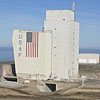
|
 |

Additional coverage for subscribers:
 VIDEO: TAKE A TOUR OF VANDENBERG'S SLC-6 LAUNCH PAD QT VIDEO: TAKE A TOUR OF VANDENBERG'S SLC-6 LAUNCH PAD QT
 VIDEO: VANDENBERG'S FIRST DELTA 4 ROCKET ARRIVES QT VIDEO: VANDENBERG'S FIRST DELTA 4 ROCKET ARRIVES QT
 SUBSCRIBE NOW SUBSCRIBE NOW

|
Lunar dark spots point to upheaval in planetary orbits
People of every culture have been fascinated by the dark "spots" on the Moon, which seem to compose the figure of a rabbit, frogs or the face of a clown. Many scientists now believe that these basins bear witness to a huge spike in impact bombardment, which is considered by many to be one of the best-preserved mysteries of solar system history.
 FULL STORY FULL STORY
 |  |

|
 |
Martian rover missions experience highs and lows
NASA's Mars rover Opportunity is trying to escape from a sand trap, while its twin, Spirit, has been busy finding new clues to a wet and violent early Martian history.
 FULL STORY FULL STORY
 |  |

|
 |
Voyager craft ventures into mysterious realm
NASA's intrepid Voyager 1 space probe has begun its journey to the stars and is now exploring the farthest reaches of the Sun's influence where the solar wind strangely interacts with interstellar space, agency officials formally announced on Tuesday.
 FULL STORY FULL STORY
 |  |

|
 |

Additional coverage for subscribers:
 VIDEO:
ANIMATION OF VOYAGER ADVENTURES QT VIDEO:
ANIMATION OF VOYAGER ADVENTURES QT
 SUBSCRIBE NOW SUBSCRIBE NOW

|
Amateurs, professionals team to find new planet
For the first time, amateur and professional astronomers have teamed up to discover a new planet circling a distant star. The planet was detected by looking for the effect of its gravitational field on light from a more distant star, a technique known as microlensing.
 FULL STORY FULL STORY
 |  |

|
 |
Radio signals decipher structure of Saturn's rings
The Cassini spacecraft has obtained the most detailed look ever at Saturn's rings, including the B ring, which has eluded previous robotic explorers. Its structure seems remarkably different from its neighbors, rings A and C.
 FULL STORY FULL STORY
 |  |

|
 |
Launch date established for ambitious solar sail
A wait in excess of four years is almost over for scientists and engineers eagerly awaiting launch of the first test flight of a revolutionary solar sail. The spacecraft has been shipped from its factory to a port in far northern Russia to undergo final preparations for its submarine launch next month.
 FULL STORY FULL STORY
 |  |
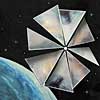
|
 |
Huygens team releases first enhanced mosaics of Titan
The European Space Agency's Huygens probe descended onto the surface of Saturn's giant moon Titan in January. Scientists have now generated new views from the descent imager to produce the first enhanced mosaic pictures.
 FULL STORY FULL STORY
 |  |

|
 |
Newest DIRECTV satellite launches into space
Millions of Americans with pizza-size rooftop satellite dishes receiving direct-to-home television signals from DIRECTV will benefit from Sunday's successful Russian Proton rocket launch.
 MISSION STATUS CENTER - live updates! MISSION STATUS CENTER - live updates!
 |  |

|
 |
Cassini shows bright ice, dirty ice at Saturn
Saturn's icy moon Enceladus hovers above Saturn's exquisite rings in this color view from Cassini. The rings, made of nearly pure water ice, have also become somewhat contaminated by meteoritic dust during their history, which may span several hundred million years.
 FULL STORY FULL STORY
 |  |

|
 |
AcrimSat solar spacecraft completes 5-year mission
A NASA satellite that measures the variability in the amount of the Sun's energy that reaches Earth's atmosphere and impacts our winds, land and oceans has successfully accomplished its five-year
primary mission.
 FULL STORY FULL STORY
 |  |

|
 |
Shuttle Discovery put through second fueling test
Engineers pumped a half-million gallons of supercold rocket fuel into the shuttle Discovery's external tank Friday, repeating a test that uncovered two unexpected problems in April. This time around, suspect fuel depletion sensors in the tank worked normally while a hydrogen pressure relief valve continued to cycle more often than normal.
 FULL STORY FULL STORY
 MISSION STATUS CENTER MISSION STATUS CENTER
 |  |

|
 |
Delta 2 rocket delivers weather satellite into space
A weather observatory was successfully launched into orbit Friday morning to build upon a 45-year history of tracking the Earth's environmental conditions from space.
 MISSION STATUS CENTER MISSION STATUS CENTER
 |  |

|
 |

Additional coverage for subscribers:
 VIDEO:
THE DELTA ROCKET BLASTS OFF WITH NOAA-N QT VIDEO:
THE DELTA ROCKET BLASTS OFF WITH NOAA-N QT
 VIDEO:
LONGER-LENGTH CLIP OF TODAY'S LAUNCH QT VIDEO:
LONGER-LENGTH CLIP OF TODAY'S LAUNCH QT
 VIDEO:
LIFTOFF AS SEEN FROM PAD FRONT CAMERA QT VIDEO:
LIFTOFF AS SEEN FROM PAD FRONT CAMERA QT
 VIDEO:
INFRARED TRACKING CAMERA FOLLOWS ROCKET QT VIDEO:
INFRARED TRACKING CAMERA FOLLOWS ROCKET QT
 VIDEO:
UMBILICALS YANK AWAY FROM DELTA AT LIFTOFF QT VIDEO:
UMBILICALS YANK AWAY FROM DELTA AT LIFTOFF QT
 VIDEO:
SATELLITE AND ROCKET LAUNCH PREPS NARRATED QT VIDEO:
SATELLITE AND ROCKET LAUNCH PREPS NARRATED QT

 VIDEO:
LAST FRIDAY'S COUNTDOWN IS SCRUBBED QT VIDEO:
LAST FRIDAY'S COUNTDOWN IS SCRUBBED QT
 VIDEO:
WATCH THE PRE-LAUNCH NEWS BRIEFING DIAL-UP | BROADBAND VIDEO:
WATCH THE PRE-LAUNCH NEWS BRIEFING DIAL-UP | BROADBAND
 SUBSCRIBE NOW SUBSCRIBE NOW

|
Clearance issue for shuttle inspection boom
As NASA runs another fueling test at the launch pad, shuttle engineers are assessing a clearance issue between the shuttle's main Ku-band TV antenna and a new on-orbit inspection boom that could delay the transmission of post-launch images of the ship's redesigned external tank.
 FULL STORY FULL STORY
 |  |

|
 |
Canada's space telescope cracks open a massive star
The MOST space telescope has given astronomers new clues about an exotic star, at least ten times
more massive than our Sun, spewing gas into space at a rate of more than 100 trillion tonnes per second.
 FULL STORY FULL STORY
 |  |

|
 |
Drought in the Black Hills studied from space
Despite good rainfall and record-setting snowstorms this spring, most of northeastern Wyoming, the Black Hills, and western South Dakota remain in the midst of a severe drought. Images and maps from NASA's Terra spacecraft show the signs.
 FULL STORY FULL STORY
 |  |

|
 |
|
Read our earlier news archive page.
|



